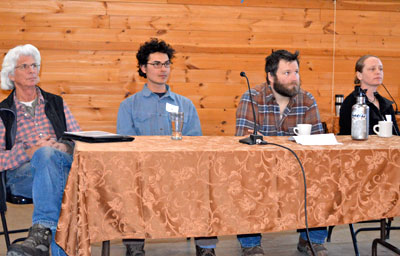 |
| At MOFGA’s Spring Growth Conference, Eric Sideman (left) moderated a panel of young growers who are addressing climate change in their operations. From the left: Bill Errickson, Mike Bahner and Tasha Brodeur. English photo |
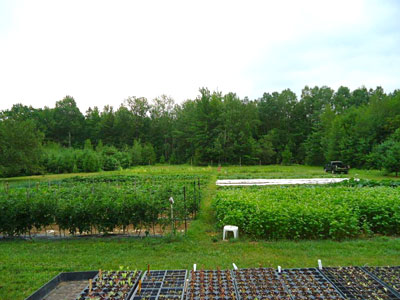 |
| Tasha Brodeur uses cover crops extensively at Tasha’s Veggies. Here, on the right, she grew a plot of buckwheat before installing a hoophouse on the site. Photo by Tasha Brodeur |
By Jean English
Maine farmers are acting now to adapt to and help mitigate climate change. During a panel session at MOFGA’s Spring Growth Conference on the topic, moderated by Eric Sideman, three Maine farmers – all former MOFGA journeypersons – talked about closed loop systems they use to try to mitigate and adapt to changing climate.
Tasha Brodeur and Tasha’s Veggies
Tasha Brodeur owns and operates Tasha’s Veggies (www.tashasveggies.com) in Parsonsfield. She grows about 1 acre of mostly heirloom vegetables using primarily human power and practicing bio-intensive and succession plantings. She also raises herbs, fruits and laying hens. Tasha’s Veggies are sold at The Newfield Farmer and Artisan market, area restaurants, an on-farm CSA and through Tiny Farms Cooperative (a local buying club).
Brodeur minimizes tilling the ground, one way to keep carbon in soils; when she does till, she often plants cover crops to help offset effects of tilling and to improve soils.
Greens, carrots and root vegetables grow in permanent beds. A wheel hoe and many “Eliot Coleman” hoes have been the main cultivation tools, although Brodeur just got a tractor.
Two years ago Brodeur had a section of pine cleared using a tractor and then brought in pigs to till the ground and add fertility – and to provide sustenance through winter. Chickens spread what pigs left behind, and provided eggs. Then the area was tilled and planted to a pea-oat-clover cover crop. Now squash, corn and beans grow there.
Another long-uncultivated field was tilled and planted to a pea-vetch-oat cover crop the first season followed by vegetables in the second season.
Yet another field grew buckwheat. “I use a lot of cover crops like oats, clover and buckwheat that are easy to handle by hand,” said Brodeur. After the buckwheat was cut, a recycled hoophouse went up in that spot. The plastic covering was left over from someone’s fish farm.
Seed saving is important for closing the loop, said Brodeur. She saves tomato seeds and grows her own seedlings.
Compost – another example of recycling – provides most of the fertility on the farm, with ingredients coming from local farms with cows and horses. Some nitrogen is added for tomatoes, eggplants, peppers and some greens.
Brodeur has never bought black plastic mulch but has recycled a pool cover into eight 100-foot lengths of mulch that she reuses every year. She also recycles salt bags from the city of Portland as mulch, and cardboard suppresses weeds in tomato rows.
An old wooden ladder was repurposed as shelving in hoophouse.
All plant stakes come from her woods – poplar the first year, but stronger maple after that.
The farm has a couple of hugelkultur beds (hugelkultur is mound culture, in which logs and tree limbs form the base of the mound), and tomatoes are growing on six 40- x 3-foot hugelkultur beds in a hoophouse this year. Brodeur is using her tractor now, while cheap oil still exists, to make more hugelkultur beds outside. Hugelkultur, said Brodeur, is best used where tilling is not possible, e.g., where a hemlock tree was recently cut down.
She held a sheet mulching party to prepare ground under four big old apple trees, where small herb gardens now grow. (Brodeur holds a lot of work parties. Many of her CSA members volunteer, and she offers four work shares – i.e., people work 4 hours per week in exchange for a share.) Brodeur usually hires one person part-time for a season.
Brodeur’s community is important for resilience, too, she said. “We created a sustainability group in our area called Ossipee Towns for Sustainability,” to look at how to make the area more resilient to climate change.
Education is also part of the cycling. “Our local sustainability group taught Sanford middle schoolers about hugelkultur,” said Brodeur. They built hugel mounds, which were planted this year. Food will go to local families in need.
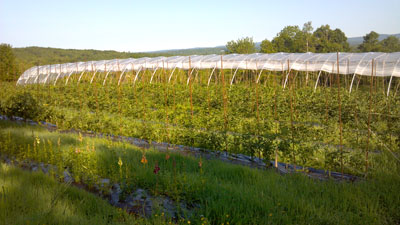 |
| Living mulches improve soil and reduce weed pressure at Bahner Farm. Photos courtesy of Bahner Farm |
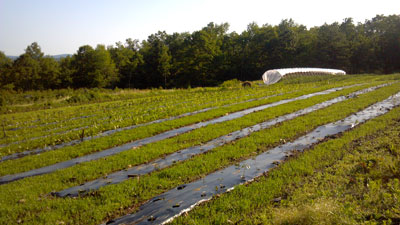 |
Mike Bahner on Bahner Farm
Mike and Christa Bahner have owned and operated their 37-acre MOFGA certified organic Bahner Farm in Belmont since 2009 (www.bahnerfarm.com). They sell through their summer and fall CSAs, at multiple farmers’ markets and at their farm stand. For the last three years they have been improving and intensifying their composting practices and integrating living mulches, orchard hugel mounds and perennial cash crops into their ecologically based farm system.
They have about 9 acres of tillable ground, of which about 5-1/2 acres are in produce and 3-1/2 in cover crops. They spread compost on any particular field every two years.
For compost ingredients, a nearby stable with about 20 horses delivers 3 to 5 yards of horse manure and urine with bedding every other day, while organic dairy manure comes from a farm in nearby Searsmont. The Bahners mix one bucket load of dairy manure with three of horse manure and add vegetable waste (less than one part by volume) from their farm. They turn the windrow with the bucket loader and put the material through a manure spreader twice at most. Their 70- x 40-foot compost pad enables them to turn compost regardless of weather.
Bill Seekins of the Maine Department of Agriculture, Conservation and Forestry helped develop their compost recipes and compost management plan. When they have a carbon-heavy batch, they use it on perennials, such as raspberries.
They record the compost temperature each morning, turning the pile at least one to two times more than National Organic Program requirements. “The pile is usually so active,” said Mike, “that I have to manage it well beyond the 15 days and five turnings that are required.” It cures from a couple of weeks to six months. They use well matured compost in a hoophouse that will have harvested greens, and fresher compost on raspberry plants after harvest. They keep records to ensure that the compost is economically feasible. They stop composting in July, August and September and just accumulate material then.
Cover crops are cheaper per pound of nutrient than compost, said Bahner. But NRCS helped pay for their pad, which allowed them to proceed with compost. Still, one of the Bahners’ main farm goals is to plant, eventually, as much cover crop as farm crop. Mike saw a YouTube video of woman in Montana using living mulches between solanaceous crops growing on black plastic mulch. She believed that growing a cover crop throughout the season benefited the soil biology for her crop plants more than the sudden infusion of organic matter and fixed nitrogen that occurs when cover crops are tilled in all at once.
So the Bahners grow solanaceous crops and cucurbits on black plastic with living mulches seeded between rows – usually oats and Mammoth red clover, which are quick to establish and stand up well to foot traffic. Between pepper and eggplant rows (on 60-inch centers), Mike spreads the seed by hand with a bucket and a quart yogurt container and then walks “really fast” with a walk-behind rototiller to incorporate seed as shallowly as possible. Tomatoes and cucurbits grow on 10-foot centers, so he uses a 36-inch-wide walk-behind drop spreader there and with a small drag harrow lightly incorporates the seeds.
“So we’re growing a lot of nice biomass cover crops right in with the cash crops,” said Mike. “Because cucurbits are a vining crop, it’s very important to have the timing down so that you don’t have oats going to seed or vines that you don’t want to disturb.”
He adds soil amendments, makes beds, lays plastic, plants and then immediately seeds the living mulch. “That could be tweaked a little,” said Mike. “If we’re going to get rain, I might seed it before we plant.”
For squash, he tries to make beds well ahead of transplanting. He wants the living mulch seeded before he applies row covers to direct-seeded and transplanted squash so that he can mow the oats before the plants vine into the pathways. He mows before the oats get to the milk stage. “Once the clover is established, you can mow whenever.”
Despite a bad galinsoga weed problem in their field, “it is unbelievable, the suppression that even oats and clover will do to galinsoga,” said Mike. “Certainly there’s galinsoga in there, and it will still go to seed when you chop it’s head off, but rather than till that every seven to 10 days,” they are happier to suppress it. “We have had such a hard time managing weeds in cucurbits in the past that almost anything is better,” said Mike, adding that perennials such as quackgrass would be more difficult to control this way.
They mow the cover crop with a walk-behind sickle bar or a riding mower. The sickle bar enables them to get right to the edge of the plastic. That’s a little more difficult with a riding mower, but they ride the front wheel right on the shoulder of the plastic and have the mowing deck on the highest setting, just to knock the oats down. The mulch remains on the ground over winter.
Perennial cash crops – grown to reduce the amount of tillage used – include cut flowers, some on black plastic and some with wood chip mulch in paths – and raspberries. Perennial clover and fescue grow between raspberries.
Mike said he loves everything about growing raspberries, especially given the good air flow and soil drainage on their site. They are expanding from four to seven varieties to lengthen the harvest season. They topdress with a lot of compost at pruning, which ideally happens as soon as possible after the harvest season ends. Raspberries can survive a good hit in bad winters, said Mike, but they have seen some damage after ice storms.
They planted asparagus a few years ago but have not started selling it yet.
In their half-acre family orchard, growing on a hillside on well drained soil, they made hugel mounds to trap moisture when they very occasionally irrigate. Mike plowed a double trench on the uphill side of each tree row with a two-bottom moldboard plow, throwing soil downhill to create a swale and berm. He filled the trench with slash and tree limbs from an area they were clearing and covered the mound with blueberry duff, municipal leaf waste and, finally, compost.
“We’re still building hugel mounds,” said Mike. “We’re going to experiment with growing pumpkins, eggplant and broccoli in the mounds.”
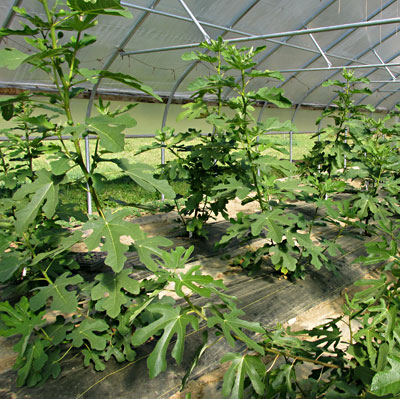 |
| A warming climate and the protection of a hoophouse may enable Bill and Lauren Errickson to grow figs in Maine. Photo by Lauren Errickson |
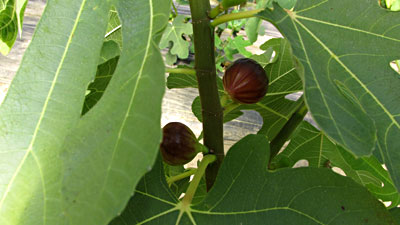 |
| Ripe figs grown in Brooks, Maine. Photo by Lauren Errickson |
Bill Errickson on Singing Nettle Farm
Bill and Lauren Errickson have owned and operated Singing Nettle Farm (www.singingnettlefarm.com), a horse-powered, off-grid, MOFGA certified organic, permaculture-inspired farmstead in Brooks, since 2010. While studying sustainable agriculture, natural resources, biology and ecology in college and graduate school, the Erricksons decided they wanted to provide food and medicine to their community while rehabilitating a natural ecosystem. This two-person, two-horse operation is off-grid but has a small array of solar panels, mostly for the well pump.
Singing Nettle Farm offers fresh seasonal produce, flowers and herbs through its approximately 30-family CSA program. The Erricksons also sell herbal tea blends, perennial nursery stock, annual seedlings, and they offer permaculture design and consultation services. They sell to the grower- and consumer-owned Marsh River Co-op in Brooks, to a local restaurant – Ralph’s Cafe, to the Waldo County General Hospital in Belfast and at the Common Ground Country Fair – all within about a 10-mile radius of their farm.
To live in right relationship within their ecosystem – moving toward a more biodiverse, more climax-stage system of ecological succession – they focus on soil health, on plant and animal diversity, and on pollinators and other beneficial insects. “If we’re doing a good job,” said Bill, “we’ll see more wildlife each year.”
Another goal is to watch cash flow so that they’re financially solvent and stable enough to continue farming.
The farm includes a pollinator garden with a small tree/medicinal herb/shrub polyculture; a perennial flower garden; a high tunnel; a large comfrey bed along the lower side of the high tunnel; broom corn; a stone fruit orchard; just over an acre of annual vegetables and flowers; and another 2 acres of young woody perennials integrated with herbaceous flowering and medicinal perennials. The Erricksons sell their perennial plants directly to customers and wholesale to Fedco, which receives primarily black walnuts, butternuts, buartnuts, heartnuts, shagbark hickories, hazelnuts and some hardy kiwis.
They sell seed garlic, one of their big crops, at the Common Ground Country Fair, and they sell garlic scapes through their CSA. “It’s food, it’s medicinal, and we can plant it in the fall,” said Bill. “In a two-person operation, there’s only so much we can do in the summer. The CSA ends in early October. In mid-October we’re planting garlic again and getting fields ready. Trees are dug in November.”
‘Kodiak’ mustard (Brassica juncea) goes in after the garlic harvest, to build soil, conserve nutrients, provide late-season nectar to pollinators and suppress diseases and nematodes through its biofumigant properties. Still, they rotate garlic away from the plot for at least four years. The mustard winterkills, so is easy to cultivate in spring.
They grow dynamic accumulators, including comfrey, nettles and yarrow – plants that can accumulate some nutrients from the soil better than other plants. From these they make teas to water plants, or they add the accumulators to the compost pile.
Comfrey growing on the downhill side of the hoophouse takes up nutrients that may run off. Bumblebees love comfrey, so the Erricksons let it flower but cut it with pruning shears before it goes to seed and becomes a weed. Comfrey can be cut to the ground at least three times per year, so it is a source of on-site regenerative perennial fertility.
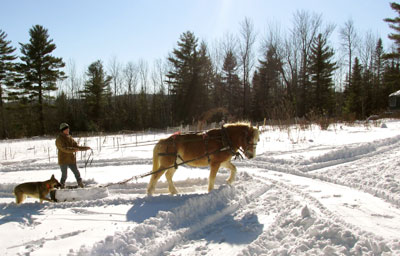 |
| Horses play many important roles at Singing Nettle Farm. Lauren even uses them in winter to pull an old tractor tire with two pieces of wood attached to the front to make a V-plow, so that she can keep paths open. Photo courtesy of Lauren Errickson |
|
A Draft Horse Philosophy By Lauren Errickson As farming continues as part of the Maine rural lifestyle, so lives the tradition of working horses in the field and forested landscape. While the historical thread of the human-horse relationship has worn thin in many places, a bond remains that deeply ties us to our equine partners. Keeping horses active in the working landscape on our diversified organic farm is one small way to honor and preserve the relationship that humans have developed with horses over thousands of years. In the world of vegetable production, we often hear comparisons between farming with horses and the use of a tractor. Granted, both a horse and a tractor can do the work of a farm, and both generally necessitate human participation. A common perception is that horses represent a slower, lesser efficient model. On our farm, though, we “scaled up” from a human, hand-powered system of vegetable, herb and flower production to a horse-powered system, gaining efficiencies hand over hoof. We’ve come to believe that a much more appropriate comparison is relating our team of horses to a pair of apprentices: We provide food, housing and adequate training, and in return find ourselves working in right relationship with a willing, dedicated team that also offers a form of companionship. Horses are herd animals by nature, and most thrive in a social situation where they interact with herd members regularly. This often includes other horses, but most equines willingly accept, and enjoy having, humans as part of the herd. As with good neighbors, herd members build a relationship of trust and come to depend on one another. My horses depend on me for their basic needs of food, shelter and companionship; in return they accept my role as herd leader and decision-maker. In new, stressful or frightening situations, the relationship I have with my team allows them to accept my reassurance to move forward. Likewise this relationship fosters a willing response when I request work from my animals. As a grazing species of prey living on plains and prairies, horses evolved to move, and will, given the opportunity, stay mobile most of the time. By folding the horses into necessary tasks within the farm system, their desire to move is satisfied, and with careful and proper training, horses often come to enjoy their work in harness. Horses are creatures of habit, and catering to the horses’ routine shapes my routine; my mornings begin with an often brisk walk, or sometimes a snowshoe, to greet my equines at the barn, where the sweet scent of hay fills my nose and morning nickers of gratitude for impending breakfast sound softly through the air. Caring for the horses folds into the days on the farm a very real reminder of all that we are nurturing in our work on the land. While working with horses is not for everyone, as there are plenty of challenges amidst the pleasures, those of us who are called to the lines experience a dual sense of purpose and gratitude that is unequaled by many other things. There is magic in horses that is not rivaled by mechanical means. They have a place in my fields and my forest, and a place in my heart. |
They don’t buy in any compost but make it from manure from their two Haflinger draft horses – a small breed of about 1,000 pounds. Per pound of horse, said Bill, Haflingers can pull more weight than a larger horse. Their small flock of laying hens also provides manure for compost. Bedding comes from poplar shavings from local ladder-maker Peter Baldwin. They borrow a neighbor’s tractor to turn their compost.
The horses till the ground and hill potatoes. They use smaller equipment, which is easier on the ground and cultivates only the top 6 inches or so. In winter the horses pull an old tractor tire with two pieces of wood attached to the front to make a V-plow, while Lauren stands on top of the tire to weigh it down and guide the horses. This opens up paths around the farm.
Their horses eat grass – a renewable energy resource – in season. Hay comes from a neighbor’s farm and is viewed as a nutrient input as well as a feed source for their horses. The hay becomes manure, which is composted and added to fields.
The Erricksons cut grass for mulch on their farm with a horse-drawn sickle bar mower and a hay rake. They are working toward cutting their own hay, but currently lack a barn for storage.
Under a SARE grant the Erricksons remineralized pastures to see if changing the soil chemistry would shift pasture species composition away from weed species toward more palatable grasses. For example, dandelions thrive in conditions of low calcium and low phosphorus, while orchard grass “loves” calcium and phosphorus. Adding those nutrients to the soil may encourage grasses rather than weeds. They saw some positive results after a two-year study. They see the grass as a long-term perennial bank account for nutrients. While some nutrients leave the farm in produce, these farmers try to keep nutrients on the farm as long as possible.
The horses are good mowers, and because they’re small, they can get into tight places. The Erricksons fence off their young stone fruit trees, for example, and the horses graze between the rows.
At the base of plum trees, they plant medicinal herbs, flowers and bulbs – including daffodils, which provide income as cut flowers and as bulbs to sell.
They rotate their hens around the farm for fertility and to scratch up horse manure. The horses drag a moveable hen house on skids, and hens are penned within an electric fence.
They built a 12- by 90-foot high tunnel with a Johnny’s Selected Seeds hoop bender. They grow tomatoes and melons here in summer, and in early October transplant lettuce and interseed cover crops – oats, horseradish, mustard, peas – whatever seed is left over. After harvesting the lettuce, they move their chickens into the house in late November. The cover crop takes up nutrients and helps feed the chickens through winter. The chickens also get table scraps, sunflower seeds and organic feed – and they fertilize the soil for next year’s tomato crop, helping break down diseased tissue and eating hornworm larvae.
The Erricksons also keep bees and grow plants for them, including corn.
Their cut flower CSA provides an income as well as habitat for other creatures. And plantings of umbeliferous flower species attract beneficials, such as parasitic wasps that help control cabbage worms. The pest shows up before the predator, so this type or control takes patience, said Bill.
As part of a three-year SARE grant, four varieties of figs supposedly hardy to zone 5 (Singing Nettle is right on the zone 5 line) are growing in a high tunnel, which adds a half zone or a zone. The plants, obtained from Kerry Sullivan in Laconia, N.H., were set in the ground last spring and produced some figs that first year. (They produce on new wood.) The Erricksons are evaluating yield, winter dieback and taste. Every other plant of each variety was wrapped in Agribon row cover to see if that improves winter survival. Figs are woody perennials, so will sequester carbon; are nutritious and have been cultivated since about 9,000 B.C. The Erricksons will propagate and sell plants of varieties that grow well. With climate change, the plants might not have to be in a hoophouse in the future.
The health of the surrounding forest and its resources are another part of the Erricksons’ healthy ecosystem approach to farming. From their forest and with their horses, the Erricksons selectively harvest damaged trees for firewood and for wood for building. They use wood to heat the 8 x 16 greenhouse attached to their house, where they start seedlings. They are managing their forest for climax succession and for healthy trees – red oak, yellow birch, white pine, hemlocks. They either chip hardwood brush and use it for mulch on the farm, or pile the brush in the woods to create wildlife habitat and return fertility to the forest soil.
They planted blueberries where an old softwood pile had sat, because the ground under the pile (since moved to the woods) had great biology. They mulch blueberries with wood chips from their forest.
They grow shiitake mushrooms on alder logs. Alder is often considered lower value wood, but they coppice it, taking the two or three biggest stems from each clump to inoculate and allowing the rest to regrow. The shiitake won’t live as long as on oak or maple but will fruit heavily one year from inoculation. “Mushrooms can ‘eat’ alder quickly and crank out the mushrooms,” said Bill.
When their forestry work creates gaps in the woods, they plant culls from their woody plant nursery – including a filbert that is a hybrid American hazelnut, beaked hazelnut and European filbert and that resists eastern filbert blight. Hazelnuts can live for 500 to 1,000 years, said Bill, “so here’s a carbon sink that produces a nut that provides carbohydrates, oil, protein, vitamins for people and animals. The soil won’t have to be cultivated again or planted possibly for 500 years.”
As does Tasha Brodeur, the Erricksons are also cycling their knowledge: They now mentor other MOFGA journeypersons.
